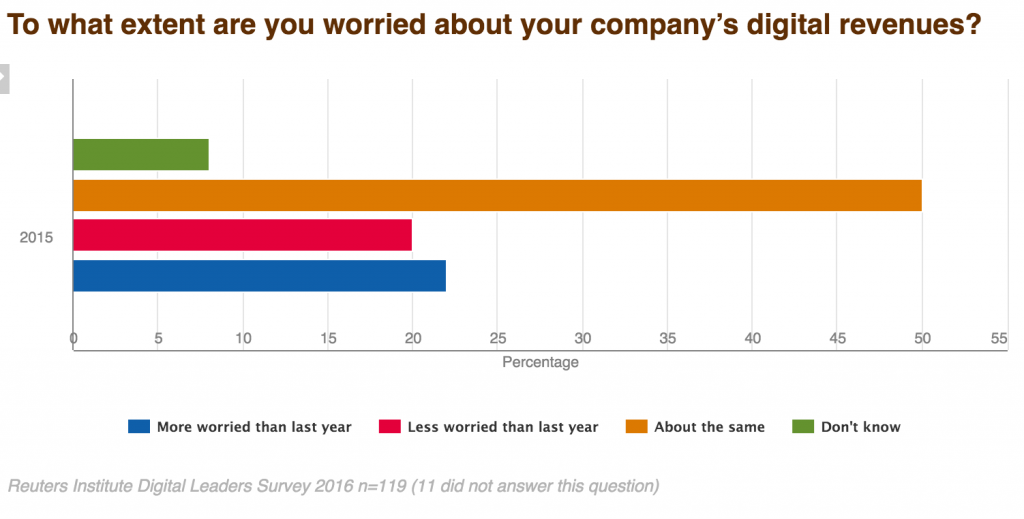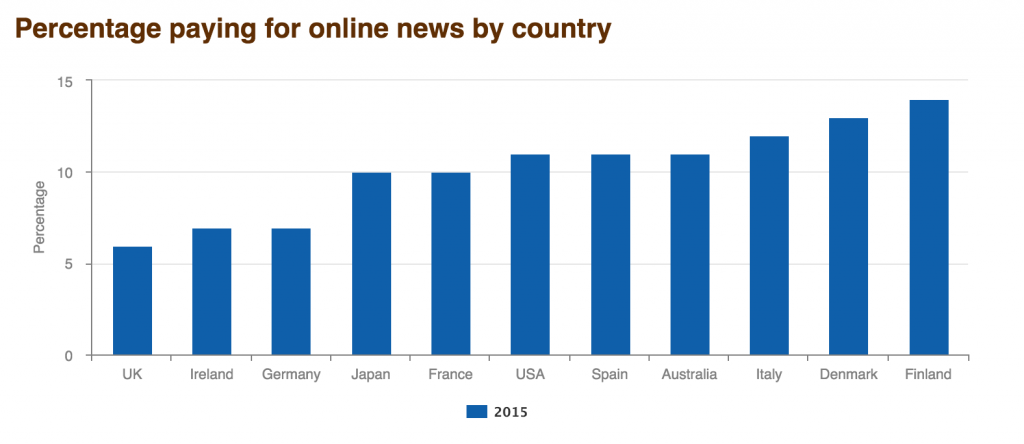Publishers feel more pressure on their digital revenues today than ever before. Print numbers are going down at the expense of advertising revenues; on the digital side there’s adblocking to contend with, among other things. Over the past years, we have seen many publishers inside and outside the US cut costs to combat declining revenues. Even British newspaper The Guardian, who wasn’t significantly affected so far, recently announced it will have to cut costs by 20% or £50 million over the next three years. However, it’s imperative that publishers evaluate their existing business models and user behaviors to find the right balance of content delivery with financial sustainability.
Business model innovation
Unsurprisingly, the problem has been on publishers’ radars and will also be a key topic for the coming year. Nic Newman from the Reuters Institute for the Study of Journalism recently published his take on key developments for 2016 based on a survey of leading editors, CEOs and Digital Leaders. Those surveyed say business model innovation is one of four strategic priorities for this year. About 50% of these people in the industry are still equally worried about their company’s digital revenues, while 22% says they’re more worried.
Adblocking shows how traditional advertising might not be a sustainable source of revenue for websites anymore. It’s a matter of news value in the consumer’s perception. People will not pay if they don’t see value in the content but they might just as easy go to the outlet offering them no or fewer intrusive ads instead, where they could read the same news. This requires a new approach: publishers not only need to think again about monetization but also about adding value.
Interest in paywalls
Many big publishers have been experimenting with new business models to counter this. We’ve seen many paywalls being introduced – and others removed – but so far consumers haven’t really been interested in paying for online news, besides a few exceptions. In 2015, around 11% of US consumers paid for news, while only 6% of UK consumers said they pay to get access to online news. We recognize this, too. Based on our own survey of more than 500 US consumers, 60% of respondents said they would never pay to remove ads. However, a significant number (40%) of people would be willing to perform some kind of exchange as well. We’ll be publishing more on this in the coming time, so stay tuned!
Other examples show people are willing to pay as long as the content is unique – they can’t get it somewhere else. For instance Dutch ‘De Correspondent’ lets readers follow correspondents (experts) who write longer investigative pieces on topics such as health, privacy, or society. The website attracted 43,000 paid subscribers (€6 monthly or €60 annually) so far in the Netherlands and will try their luck in the US this year.
Micropayments & subscriptions
Another startup taking a leap of faith in the US market is Blendle. The Dutch digital newsstand decouples articles from newspapers and magazines, and lets users pay a small amount to read them, so-called micropayments, in a model that’s similar to iTunes. Along with curators on different subjects, curated daily newsletters, and an integrated social component, it has been quite successful so far.
The company received funding from newspaper moguls New York Times and Axel Springer, and has signed up 650,000 users from the Netherlands and Germany. About half of these users are under 35, an age group particularly interesting to publishers because they aren’t the ones typically reading newspapers. This Spring, Blendle will launch in the US with a “really, really incredible” list of publishers, they claim. However, some publishers are skeptical of the idea of having people pay a small fee for every article, unless these services get buy-in from all publishers. This would lower the threshold for people to start using it.
Some publishers have been successful experimenting with their subscriptions. The New York Times, for instance, is offering discounted subscriptions for 4-week digital access to its articles and seems to be quite successful in doing that. Late last year the company announced it signed up 1 million digital-only subscribers, an impressive number, especially considering their print circulation has decreased by almost 200,000 from 2013 to 2015.
Native advertising
2015 has also seen an uptake of native advertising – advertising in the same format as original content – on publishers’ digital properties. With consumers’ stance against intrusive ads and the increase of ad blocking, it is expected we will see more and more publishers embrace this type of advertising, especially on mobile where traditional advertising is often not suitable or too intrusive. Data from BI Intelligence shows how spending on native ads is expected to grow to $21 billion in 2018. By 2020, native ads will be the majority of display media across Europe, €13.2 billion in total. There are still some challenges to be overcome, however.
Summary
A significant amount of people in the media industry are still worried about their company’s digital revenue. Business model innovation is among their strategic priorities for this year, but monetizing your content isn’t an easy task. So far publishers have been experimenting with paywalls and some have ceased their efforts as only minor shares of users want to pay for news. Those who do offer unique content are more successful, but have yet to prove how they would scale in other countries.
At the same time alternatives such as discounted subscriptions and micropayments are emerging, but the latter is still facing some skepticism from publishers. While traditional advertising is often found to be intrusive and not suitable for mobile, perhaps the biggest challenge and opportunity will be to get publishers to adopt native advertising. It’s imperative that publishers evaluate their existing business models and user behaviors to find the right balance of content delivery with financial sustainability.
Do you want to create additional value to your content by leveraging content from social media? We’d love to talk about it together.
Featured photo credits: Flickr CC – R/DV/RS

